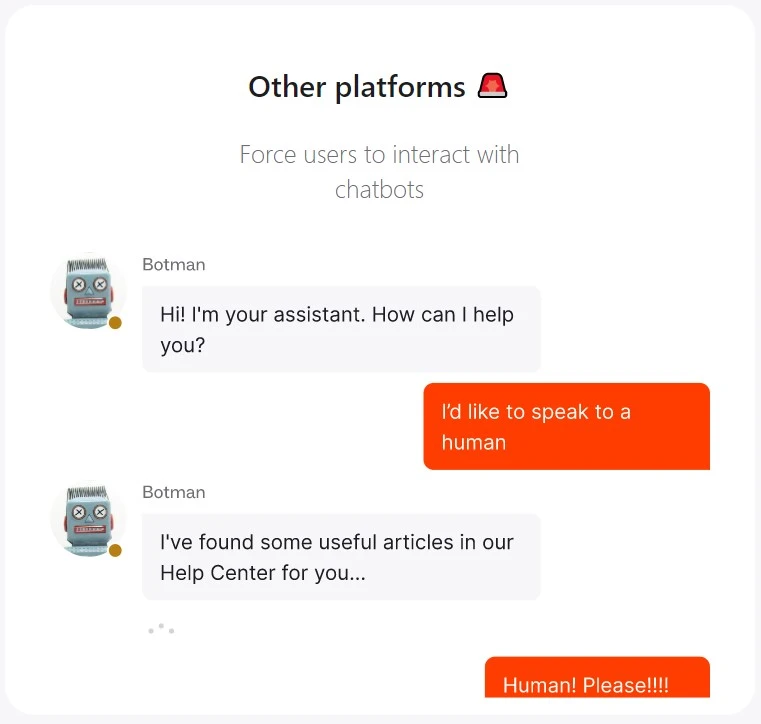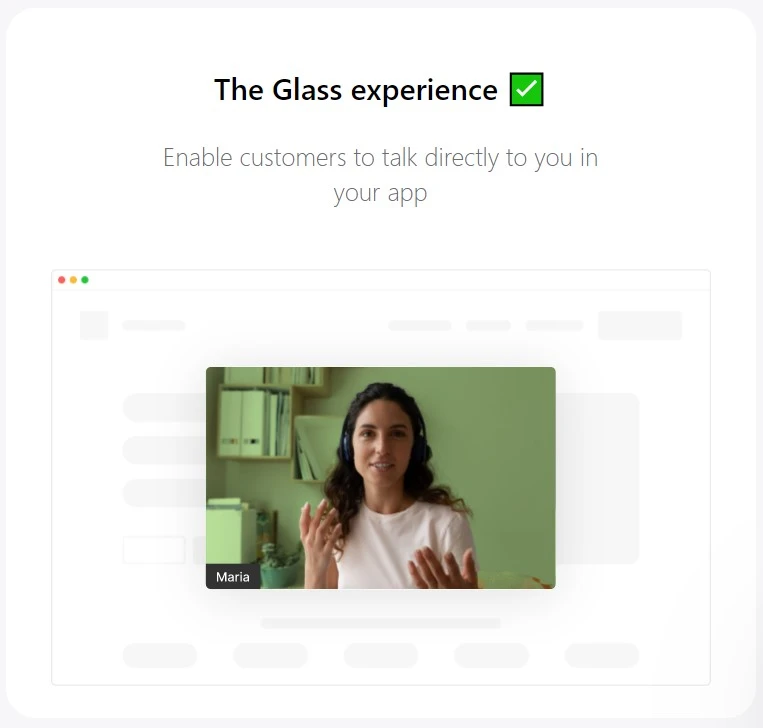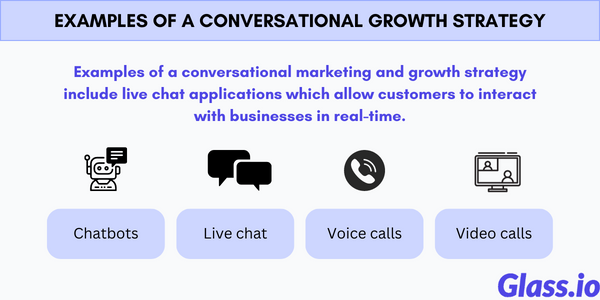
5 Steps to Implementing a Conversational Growth Strategy Katherine Manning February 08, 2023
When your organization only has seven seconds to make a first impression, it’s critical to create the right one. Conversational marketing is an emerging trend in the marketing world, and it's all about implementing a conversational growth strategy.
This post outlines examples and steps to implementing a conversational growth strategy in your business.
What is "conversational marketing" and "conversational growth strategy"?

As a business owner, you're probably familiar with the growth concept. It's an integral part of any company's life cycle and something that many of us strive for to grow our businesses.
But what exactly is a conversational growth strategy?
Conversational marketing and a conversational growth strategy is a dialogue-oriented way to grow your business that focuses on building authentic relationships with your customers—instead of just pushing products or services at them.
Why does a conversation-centered approach work?
People want to feel like they know who you are as a company before making a purchase decision—because when it comes down to it, trust is critical for shoppers today. Invariably, 59% of consumers prefer to buy from a brand they trust.

By encouraging potential buyers to talk about their needs and wants rather than just making sales pitches at them, you're creating a more valuable and meaningful exchange that will have an impact on customer retention.
We live in a world where we can be connected to anyone, anywhere and anytime. We can text, tweet, and email our friends and family from our homes. However, as shoppers become more connected to each other through social media channels like Facebook, Instagram, or Twitter, they also want to feel closer to the brands they buy from by building relationships with them.
A conversational growth strategy is more than an inbound marketing strategy, inbound marketing techniques, or using a marketing chatbot. Conversational growth strategies build relationships by delivering the right message to the right person through direct conversations.
What are the steps to implementing a conversational growth strategy?
Here are some simple steps you can take to develop a conversational marketing and conversational growth strategy for your business.
Step 1. Identify your target audience.
Who are they, what do they like, and what do they want to know more about?
Giving this information to your sales team will enable your marketers and sales people to engage customers using relevant messaging, the right channels, and the right amount of personalization. Here's Seth Godin with 1 question to ask yourself in order to find your audience.
Step 2. Get to know your target buyers in person.
By conducting interviews or surveys, your marketers and sales teams will better understand their needs, as well as their preferred methods of communication with brands like yours (email, phone calls), along with their preferred channel.
Step 3. Select useful apps for interacting with your target buyers.
Social media channels like Facebook Messenger and Instagram Direct enable you to have direct conversations with potential and active customers.
Additionally, you'll want a way to speak directly with website visitors and leads. This is where live chat and in-app video chat software installed on your website can help you get in front of your customers right at pivotal moments in their customer journey.
For example, Glass.io is an in-app video chat plugin that allows sales teams to talk in person with their customers through video chats—directly from a company website.
The Glass.io plugin helps companies to develop more authentic relationships with buyers by allowing leads to have conversations with a customer service agent or brand representative.


Image. Use in-app video chat to reach your customers at crucial moments of decision.
Other popular tools for sales teams focused on conversational marketing include Intercom or implementing a live chatbot on your site.
Step 4. Create relevant content.

The most important thing regarding your content marketing efforts for a growth strategy is to ensure it's valuable for your audience.
In fact, content with the objective to build relationships is a vital conversational marketing tactic and inbound marketing technique.
Relevant content will help you grow an engaged following by giving readers all the information they need—whether that means news articles about current events in the industry you are targeting, etc.
For example, create blog posts around topics that matter most within your industry. Then share these posts across all platforms—social media channels like Twitter, Facebook, or LinkedIn; and email newsletters sent out weekly/monthly/quarterly, depending on how often you want them published.
Step 5. Train your inbound marketing and sales team to use conversational growth tools.

If you're using pre-written scripts as part of your conversational strategy, don't be surprised if that backfires. Live chat with real live representatives is what will boost your conversational marketing. Chatbots—not so much.
Make sure your inbound marketing team knows how to use the new tech that you're using for your conversational growth strategy—aside from knowing how to provide that human element customers are presently craving.
Examples of a conversational growth strategy
Examples of a conversational marketing and growth strategy include live chat applications which allow customers to interact with businesses in real-time.

a. Chatbots
Chatbots are one example of a conversational growth strategy tool, which helps to answer customer questions quickly and efficiently by using a set of pre-programmed Q&As. Popular chatbot tools include Zendesk Support Suite, Freshworks, etc.
b. Live chat
Live chat on websites helps move buyers through the marketing and sales funnel by providing help at crucial moments in the pipeline. Popular live chat software includes Intercom, Tidio, etc.
c. Voice calls
Voice calls (phone calls) allow companies to connect and have a one-on-one conversation with customers, making them feel heard, special, and unique. Popular voice call tools include auto dialer software.
d. Video calls
Video calls engage buyers at the right time—when they are on your site, which allows you to have helpful conversations that reduce uncertainty regarding their purchase decision. Popular video call tools include Glass.io, Qualified, Drift, etc.
Frequently asked questions
What is a conversational growth strategy?
Chatbots and other live chat tools can provide a means to engage the buyer in a live conversation. If implemented properly, the approach can minimize the friction of the buyer and increase conversion on a website.
What is conversational growth?
Conversational growth means increasing the success of your organization through developing individualized conversations with potential customers.
What is a conversational strategy?
A conversational strategy is about turning every conversation into an opportunity. A conversation is where two or more parties exchange sentiments, observations, opinions, or ideas.
What is conversational sales?
Conversational sales is an interactive approach to B2C or B2B sales which involves engaging with potential customers through various online channels, such as chatbots and live chat. Customers are provided with information rather than being pushed to make a purchase.
What are conversational growth strategy examples?
Chatbots
Livechat
Voice calls
Video calls
How can a company teach inbound sales teams conversational marketing?
Hubspot Academy provides a couple of free resources that provide inbound sales teams with a primer on conversational marketing. "Developing a Conversational Growth Strategy" is part of Hubspot's certification course for Inbound Marketing Training, consisting of 4 videos and a total run time of 17 minutes. "The Beginner's Guide to Conversational Marketing," is a free guide, also by Hubspot, covering all the basics of conversational marketing, including the definition, action plans, case studies, and more.
In closing
A conversational growth strategy should provide you with a systematic way to ensure that your company is having authentic conversations with website visitors and potential buyers.

These conversations will help you create more satisfied customers, increase customer loyalty, improve lifetime value and advocacy, and achieve more revenue.
When discussing "authentic" conversations with buyers, we mean something different than you might think. It's not just about being honest or transparent—it's about being human.
You want people who trust you enough to feel comfortable sharing their true feelings with you so that they can get real answers from someone who understands them as individuals rather than just another number on a spreadsheet somewhere in some far-off office building somewhere else in town (or even across town).
Use the steps outlined in this article to implement a strategy that will help you resonate and turn your leads into long-time clients.
Katherine Manning is an accomplished sales professional and B2B/IT focused writer. She worked at Microsoft and IBM, where she managed all stages of the Solution Sales process including building and developing relationships, identifying opportunities, engaging partners and moving business from opportunities to closings. Her articles have appeared on Yahoo! Small Business Advisor's page, Sweet Lemon Magazine, The Iowa City Owl, Seven12 Magazine, Newsiosity, The Purple Cow Agency blog, Personal Finance Hub and Business 2 Community.
About Glass.io
With Glass.io, you can reach across the screen and help visitors make a buy decision. See exactly how visitors use your website in realtime, trigger a notification to the right sales rep when they show buying intent, and start a personalized conversation (chat or video) at the perfect moment.
Plug your leaky sales pipeline by engaging with your website visitors while you have their attention. Sign up for an account here.